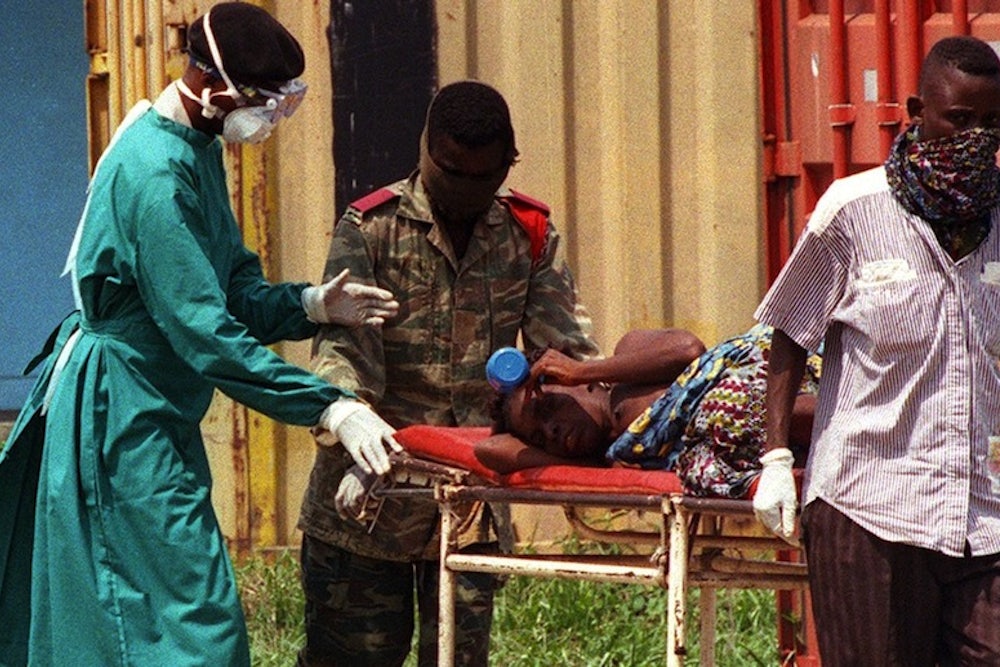Three impoverished, tiny West African nations are in a collective state of siege, their people surrounded by a microbial enemy, the Ebola virus. In response to months of inaction, followed by ineffective measures, the governments of Sierra Leone, Liberia and Guinea have escalated their counterattack on the virus, imposing cordons sanitaires aimed at isolating entire regions of their countries in hopes of containing the enemy. It may slow the virus’ spread, but it will not be sufficient to stop Ebola or lift the state of siege.
In recent days I have heard many media accounts of these governments’ deployment of military personnel to cordon off the hardest-hit parts of their countries—accounts framing these actions as unprecedented in humanity’s battles with Ebola, possibly inhumane or overly severe. These accounts are inaccurate.
I was in the Ebola outbreak in Kikwit, Zaire (now the Democratic Republic of Congo) in 1995. As I described in Betrayal of Trust, dictator Mobutu Sese Seko, who also ruled the nation with an iron hand during the first known Ebola outbreak in 1976, wasted no time once the virus’ presence was confirmed in foreign laboratories. All plane flights to the beleaguered, sprawling town of some half million souls—Kikwit—and its sole highway were shut down by the military.
Bordered on all but one side by a vast rain forest, Kikwit was a sprawling mess of a place that despite its population size lacked electricity, running water, sewers, any form of news services, phones, or an airport. Villagers had over decades settled in Kikwit, but continued to live as they had in rural areas, with the exception of trade—the whole point of moving to the messy metropolis was to sell goods extracted from the rain forest to truckers that would haul valuables to the nation’s distant capital, Kinshasa. Mobutu’s 1995 cordons sanitaires was brutally successful, as all trade to the Kikwit region ground to a halt, the desperately poor people were fully isolated to war with Ebola on their own, and few outsiders were able to find ancient military aircraft willing to fly to the town, landing on its “runway,” a weedy soccer field. When a group of war weary journalists fresh from the killing fields in Rwanda collectively booked a plane, spending a day in Kikwit, the military placed all of them under arrest upon return to Kinshasa. Though they were eventually released, one of the reporters fled across the Congo River to neighboring Congo Brazzaville. If Ebola had escaped Kikwit, its most likely carriers would have been journalists—including myself.
Inside Kikwit, the World Health Organization and Zaire medical teams erected further cordons sanitaires, isolating burial and treatment zones from the general population. And fantastically heroic local Red Cross volunteers, protected by little more than big cumbersome rubber gloves and boots, plastic aprons and overly-reused face masks, gathered up the sick and dead, hauling them behind the yellow taping denoting the cordoned zones.
If similar cordons sanitaires had been imposed strategically across Sierra Leone, Liberia, and Guinea during the initial outbreak stages in the spring, we probably would not now be facing an epidemic that threatens to spread in the most populous nation on the African continent, Nigeria. Only outsiders, such as the Nobel Prize-winning Médecins Sans Frontières, erected small cordons, insufficient to control the virus’ spread without government military and police backing. The governments failed to provide such enforcement until this month.
And now Africa, its governments having little faith in current Ebola control measures, has effectively erected a cordons sanitaires around the three nations. Nearly all commercial flights to the region from as far away as Cape Town have been cancelled, roads out to neighboring nations are blockaded, trade has ground to a full stop, and the continent is watching, praying the Ebola killing fields remain on Liberian, Sierra Leonian, and Guinean soils.
Meanwhile domestically it is hard to put much stock in the belatedly erected cordons because they seek to isolate the villages located at the juncture of the three nations without addressing rampant spread inside the large, chaotic cities of Monrovia, Freetown, and Conakry. The virus will continue to find victims so long as meaningful barriers remain elusive.
How long will this state of siege last? Recent statements from WHO, MSF, Samaritan’s Purse, and other institutions leading the fight alongside the governments warn the world that it will be at least six months, and quite possibly a year, before Ebola can be defeated. Despite all the brouhaha here in the United States and Canada about application of experimental drugs and vaccines never clinically tested for safety or effectiveness to the African crisis, this siege will end not with magic bullets, but smart, heroic strategies that find infected people swiftly, place them behind cordoned quarantine barriers, and bury the dead rapidly after their demise without families’ contact or viewing. Yes, it is heartless and can seem cruel, but strategic isolations, coupled with vast urban campaigns of capture of the infected constitute the only hopes for ending the state of siege.
